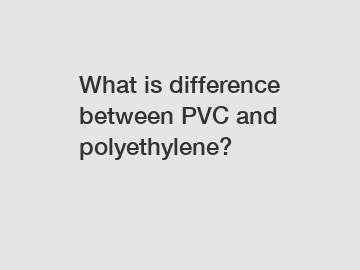What is difference between PVC and polyethylene?
In the world of plastics, two commonly used materials, PVC (Polyvinyl Chloride) and Polyethylene, often find themselves in the spotlight due to their versatile applications. As consumers, it is vital to understand the key differences between these polymers to make informed choices. In this blog, we will delve into the unique qualities of PVC and Polyethylene, their various uses, and weigh the pros and cons of each material, empowering you to make well-informed decisions for your specific needs.
PVC: A Closer Look:
Polyvinyl Chloride, or PVC, is a widely used thermoplastic polymer known for its durability and versatility. PVC, a human-made material, consists of repeating vinyl chloride monomers. It boasts a remarkable combination of strength and chemical resistance, making it suitable for numerous applications across various industries.

Unique Properties and Applications:
PVC exhibits excellent fire resistance, making it a preferred choice in construction materials. It is commonly used for pipes, fittings, window frames, and flooring due to its resistance to moisture, impact, and UV radiation. Moreover, PVC's inherent chemical resistance lends itself well to applications in the chemical industry, where it is used for storage tanks, chemical pipes, and laboratory equipment.
On the downside, PVC production involves the use of chlorine gas, which raises environmental concerns. However, modern recycling techniques have been developed to minimize the ecological impact associated with PVC manufacturing.
Polyethylene: Understanding the Basics:
Polyethylene (PE), another thermoplastic polymer, is widely known for its remarkable toughness, flexibility, and chemical resistance. The raw materials used in PE production include ethylene monomers, which are derived from crude oil or natural gas.
Varieties of Polyethylene:
Polyethylene is available in various forms, including low-density polyethylene (LDPE), high-density polyethylene (HDPE), and linear low-density polyethylene (LLDPE). Each variant possesses specific properties that determine its suitability for different applications.
LDPE, with its molecular structure consisting of highly branched chains, offers excellent flexibility and is commonly used for plastic bags, films, and squeeze bottles. HDPE, with a more linear structure and high crystallinity, is preferred for its sturdiness, making it ideal for bottles, pipes, and containers. LLDPE combines the characteristics of both LDPE and HDPE, offering excellent tensile strength and puncture resistance, making it valuable for items such as heavy-duty bags and cling wraps.
Applications and Sustainability:
Polyethylene's durability, lightweight nature, and moisture resistance make it an optimal choice for packaging materials, such as bottles, bags, and films. Its excellent chemical resistance enables its usage in chemical storage tanks, piping systems, and even fuel tanks.
While polyethylene is derived from fossil fuels, advances in recycling techniques have made it a more sustainable choice for environmentally conscious individuals. Recycling processes effectively convert used polyethylene products into recycled resins, reducing the demand for virgin materials and minimizing overall environmental impact.
Choosing the Right Material:
When deciding between PVC and polyethylene, it's crucial to assess your specific requirements. PVC's strength, chemical resistance, and fire-retardant qualities make it highly suitable for plumbing, construction, and chemical applications. On the other hand, the flexibility, toughness, and recyclability of polyethylene work well for various packaging needs and other applications where durability is key.
Conclusion:
In conclusion, both PVC and polyethylene are exceptional thermoplastic polymers, each offering distinct advantages for different applications. PVC's robustness, fire resistance, and chemical compatibility make it an excellent choice for construction and chemical industries. In contrast, polyethylene's flexibility, toughness, and recyclability make it a preferred option for packaging and other durable goods.
Understanding the differences and weighing the pros and cons of each material allows you to make educated choices that align with your specific needs, while also considering environmental concerns. By making informed decisions, we not only obtain the best results for our projects but also contribute to a sustainable future.
Remember, whatever plastic you choose, always prioritize responsible usage and recycling practices to minimize environmental impact.
For more hdpe pipes for sale, dredging rubber hose, use of hdpe pipeinformation, please contact us. We will provide professional answers.

Comments
0